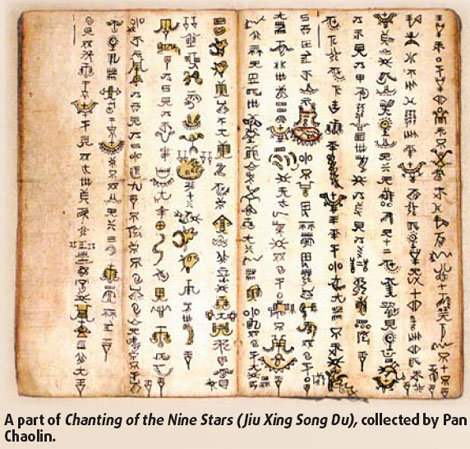Professor Pan Chaolin of the Guizhou University for Nationalities is a Shui researcher who is doing his best to study Shuishu and preserve Shui culture.

Over the years, he has collected some 600 precious books from his fellow Shui people. In Guizhou province, research institutes have collected a total of 15,000 Shuishu books. Last year, Chinese Shuishu, a huge collection of 160 volumes, was published.
Shuishu again came under public glare this March, when eight Shuishu books of the highest value were included in the nation's first ever National Classics Treasures List. The 2,392 ancient books are given priority in protection and research.
Among the eight books is Pan's Chanting of the Nine Stars, which "follows the theory of 'harmony between man and nature' and observes the position of nine stars in the belief that they influence human activities", says Pan.
Wu Guibiao, director of the China Ethnic Library, who visited Pan last year to appraise the book, said Chanting of the Nine Stars is "very valuable because it contains a large number of characters previously unknown".
"The Shui people threw away many old books which is why Shuishu books are so hard to find and of such great value," Wu says.
Researchers have, to date, deciphered the pronunciation, meaning and context of some 600 Shuishu characters. But Pan's book has 1,500 words that no one has been able to read.
The discovery of the old book was quite dramatic.
In the 1990s, when Pan was compiling a dictionary of minorities' religions and legends, he went back to his hometown in Sandu county, where he grew up in a remote mountain village, which got its first road in 2001.
"Both my parents were illiterate farmers and I was a naughty boy, which is why I earned the pen name 'Ren Sui A Nao' - 'Naughty Boy of the Shui People'," Pan says.
Luckily, the village had a Shuishu master named Pan Yuyin who was eager to preserve the group's cultural heritage. In the late 1950s, he taught primary school students, including young Pan Chaolin, the Shuishu characters, for free.
When he revisited the home of his first teacher, who died in 1960, Pan was shocked to find the Chanting of the Nine Stars.
The master's grandson was happy to find someone who knew the book's real value.
To find the meaning of the 1,500 unknown words, Pan sought sponsors to make stone slabs inscribed with the words and erected the "World's Number One Shuishu Stele Forest" at Sandu county. He promised to give 10,000 yuan (US$1,461) to anyone who could read the words.
Of the 60 Shuishu masters he visited, Wei Guangrong, the 13th generation descendant of a famous Shuishu master, held the most promise. But the old man admitted that his knowledge was less than a tenth of his predecessors.
Rapid economic development is drawing youngsters away from their cultural roots and Pan is worried that very few are really interested in preserving Shui culture as represented by the Shuishu masters.
"Without the Shuishu masters, the Shuishu language would be 'a dead body without a soul'," Pan says.
Not long ago, a Japanese collector offered a high price to buy Chanting of the Nine Stars, but Pan refused.
"This is a prized treasure, I hope I can unravel its mysteries in my lifetime," he says.
(China Daily September 16, 2008)